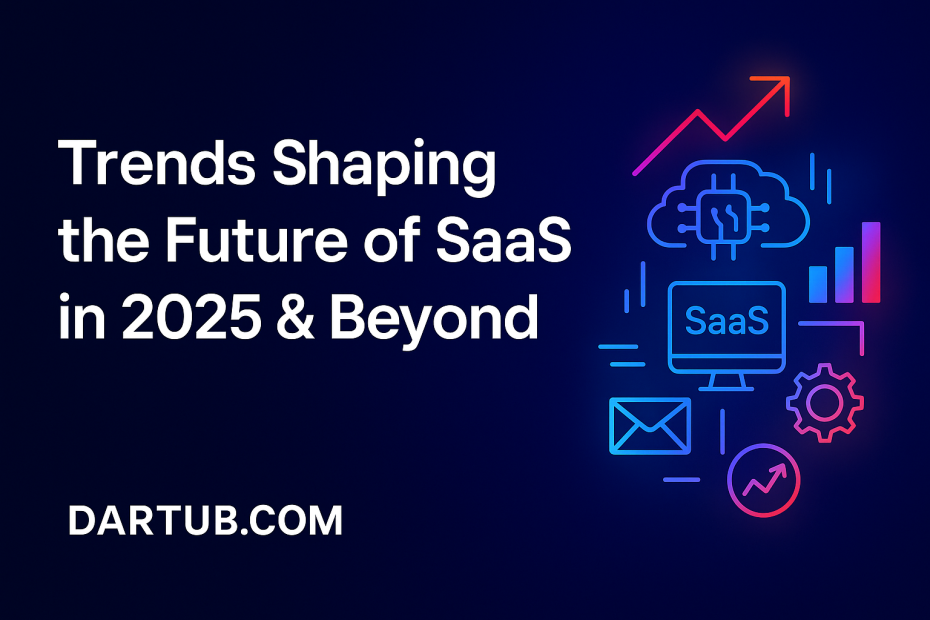The Software-as-a-Service (SaaS) industry is not just evolving — it’s undergoing a major transformation. From how software is delivered and monetized to how it’s consumed and scaled, 2025 marks the beginning of a new era in SaaS innovation. Whether you’re a startup founder, developer, product manager, investor, or SaaS user, staying ahead of these trends can give you a significant competitive advantage.
In this comprehensive guide, we’ll explore the most impactful trends shaping the future of SaaS in 2025 and beyond. Each trend is broken down with clear explanations, use cases, strategic implications, and expert-level insights to help you navigate this dynamic landscape.
Rise of AI-Driven SaaS Solutions
AI is now baked into the core of SaaS products. It’s not just about automation — AI in 2025 means proactive decision-making, intelligent customization, and predictive performance across functions.
AI-powered analytics dashboards that surface trends before they happen AI copywriting and content tools (like Jasper, Writesonic) Sales and marketing insights driven by behavioral data Custom GPT models built into SaaS platforms
AI improves speed, reduces manual errors, and makes SaaS more adaptive. As AI models become more vertical-specific, expect even greater performance optimization.
Vertical SaaS: Deep Specialization Over One-Size-Fits-All
Horizontal SaaS (generic solutions) is losing ground to vertical SaaS that serves niche industries with tailor-made solutions.
HealthTech: Telemedicine platforms with HIPAA-compliant SaaS LegalTech: Document automation and case tracking PropTech: CRM for real estate, digital closings EdTech: AI-based assessment, student progress tracking
This leads to faster onboarding, higher retention, reduced churn, and deeper integrations and workflows.
Micro-SaaS: The Rise of Indie SaaS Products
Micro-SaaS refers to small, highly targeted SaaS products built by solo founders or tiny teams.
They are built on top of major ecosystems (Notion, Shopify, Webflow), solve one specific problem extremely well, and run with low overhead.
Examples include NotionForms and Storemapper. The barrier to entry is lower, and demand for simple, integrated tools is increasing.
API-First and Composable SaaS
API-first development enables apps to work together seamlessly. Instead of building monoliths, companies now build modular, headless apps with open APIs.
This approach makes third-party integrations easier, accelerates product iterations, and offers increased flexibility. Developers can pick and assemble only the components they need.
Product-Led Growth (PLG): The New Default Strategy
Today, the product itself is the primary driver of acquisition and retention.
Users try the product free (freemium or free trial), explore its value, and upgrade organically. In-app features and feedback loops drive engagement and growth.
Key metrics include activation rate, expansion MRR, feature adoption, and viral coefficient.
Low-Code & No-Code Empowerment
Low-code and no-code tools allow non-engineers to build apps, automate tasks, and launch MVPs faster.
Popular platforms include Webflow, Bubble, Zapier, and Airtable. These tools democratize tech, speed up development, and fuel internal innovation.
Embedded Finance & Fintech-SaaS Hybrids
SaaS tools are embedding financial services directly within their platforms. This includes payments, billing, micro-lending, and capital management.
Stripe, Paddle, Chargebee, and Recurly are key players.
Integrating finance increases user retention, enhances LTV, and delivers a seamless experience.
Greater Focus on Data Privacy & Compliance
With stricter regulations, SaaS users demand transparency, data security, and compliance by design.
SaaS companies must offer regional hosting, encrypted storage, and clarity around user rights.
Tools like Vanta, OneTrust, and Drata help automate compliance.
Consolidated Platforms: Less Is More
Businesses are shifting to unified platforms that combine several core functions.
Examples include HubSpot, ClickUp, and Zoho. Benefits include reduced tool fatigue, better data centralization, and cost savings.
Green SaaS: Environmental Impact as a Competitive Edge
Sustainability is becoming a business differentiator. Green SaaS vendors are hosting with eco-friendly providers, offsetting carbon emissions, and offering ESG compliance tools.
Customers prefer sustainable vendors, and future regulations will demand it.
Usage-Based Pricing Models
The shift from flat-rate to usage-based billing is accelerating.
Models include pay-as-you-go, tiered, and event-based pricing — used by companies like AWS, Twilio, and Postmark.
These align cost with value and attract users with low upfront commitment.
AI-Powered Customer Success & Support
AI is transforming customer support by proactively identifying risks, assigning onboarding workflows, and suggesting upsells.
Tools like Gainsight PX, Intercom, and ChurnZero are leading this charge.
This improves retention while reducing the need for large CS teams.
Edge Computing Meets SaaS
To reduce latency and improve privacy, edge computing is being paired with SaaS.
This enables real-time data processing, local governance, and faster response for critical use cases like healthcare, IoT, and AR/VR platforms.
Native AI Assistants in SaaS
Expect every major SaaS platform to have its own AI assistant.
Examples: Notion AI, HubSpot AI, Microsoft Copilot.
These tools help users automate repetitive tasks, generate content, and navigate data with ease.
Strategic Outlook: What’s Next for SaaS?
AI will become invisible but deeply embedded in all workflows. SaaS will become more personalized, modular, and compliant by design.
Founders must build for speed, trust, and user empowerment. Those who prioritize interoperability, automation, and ethical data practices will lead.
